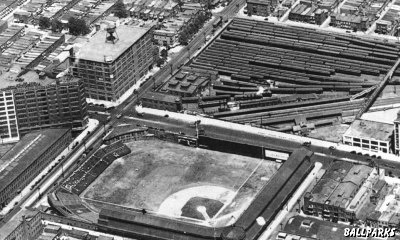Baker Bowl
Philadelphia, Pennsylvania
Tenant: Philadelphia Phillies (NL)
Opened: April 30, 1887
Reopened: April 14, 1904
First night game: Never
Last game: June 30, 1938 (14-1 loss to the NY Giants)
Demolished: 1950
Capacity: 18,000 (1895); 20,000 (1929); 18,800 (1930).
Architect: Al Reach (Phillies owner)
Builder: n/a
Owner: Philadelphia Phillies
Cost: $80,000 (1887)
Philadelphia Phillies tickets:
Location: Left field (N), West Lehigh Avenue; third base (W), North 15th Street; first base (S), West Huntingdon Street; right field (E), North Broad Street; Philadelphia and Reading Railroad tunnel beneath outfield.
Dimensions: Left field: 335 ft. (1921), 341.5 ft. (1926), 341 ft. (1930), 341.5 ft. (1931); center field: 408 ft.; right-center: 300 ft.; right field: 272 ft. (1921), 279.5 ft. (1924), 280.5 ft. (1925); backstop: 60 ft.
Fences: Left field: 4 ft. (1895), 12 ft. (1929); center-field clubhouse: 35 ft. (with 12 ft. screen on top, 1915); right field: 40 ft. (tin over brick, 1895), 60 ft. (40 ft. tin over brick, topped by 20 ft. screen, 1915).
Trivia:
- A.K.A.: Huntingdon Street Baseball Grounds (1895 to July 1913), National League Park (III) (1895 to 1938), Hump, Cigar Box, Band Box and Philadelphia Park.
- Named after Phillies owner William F. Baker.
- Nicknamed "the Hump" because it was on an elevated piece of ground that had a railroad tunnel underneath the outfield.
- Swimming pool in the basement of the center-field clubhouse prior to World War I.
- "Health Soap Stops B.O." Lifebuoy sign on the high right-field wall.
- Extra seats added in front of the fence in center for the 1915 World Series led directly to the Phillies losing the Series’ last game.
- During Prohibition the outfield wall liquor ads were boarded over with grimy blank boards.
- Home plate moved back a foot in 1925, making the right field foul pole 280.5 feet rather than 279.5 feet from the plate.
Recommended Reading (bibliography):
- Philadelphia's Old Ballparks by Rich Westcott.
- Take Me Out to the Ballpark: An Illustrated Tour of Baseball Parks Past and Present by Josh Leventhal and Jessica Macmurray.
- The Ballpark Book: A Journey Through the Fields of Baseball Magic (Revised Edition) by Ron Smith and Kevin Belford.
- City Baseball Magic: Plain Talk and Uncommon Sense about Cities and Baseball Parks by Philip Bess.
- Diamonds: The Evolution of the Ballpark by Michael Gershman.
- Green Cathedrals: The Ultimate Celebration of All 273 Major League and Negro League Ballparks by Philip J. Lowry.
- Lost Ballparks: A Celebration of Baseball's Legendary Fields by Lawrence S. Ritter.
- Roadside Baseball: A Guide to Baseball Shrines Across America by Chris Epting.
- The Story of America's Classic Ballparks (VHS).
Help us provide a better web site by completing our feedback form
IMAGES:
View inside the Baker Bowl courtesy of the Franklin Digital Collection.
Aerial view of the Baker Bowl courtesy of the Temple University Urban Archives Center.
View of the Baker Bowl site today © 1999 by Paul Munsey.
Special thanks to Leo Panetta.
Updated October 2004
Tickets to NCAA Basketball Tournament, College Football Bowl, NCAA Football, Paul McCartney and Philadelphia Phillies provided by Ticket Triangle.
BALLPARKS © 1996-2014 by Munsey & Suppes.
|






